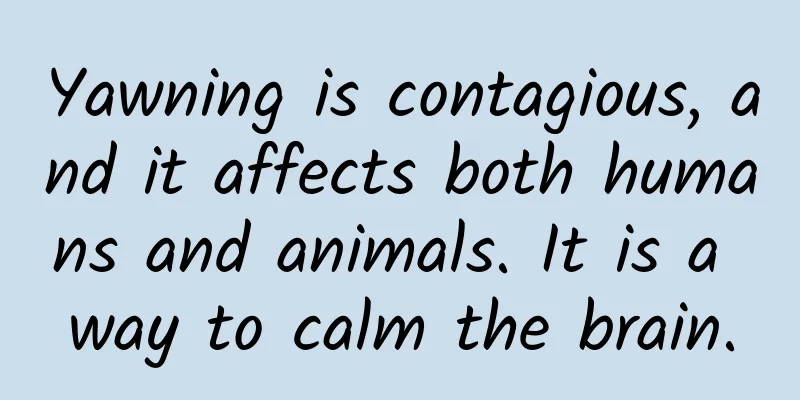Yawning is contagious, and it affects both humans and animals. It is a way to calm the brain.

|
Written by | Skin Proximity Did you yawn when you saw the picture above? Yawning is contagious. This is a law that people have discovered a long time ago. In 1508, someone proposed the theory that "yawning is contagious", and it has been studied for hundreds of years since then. Why do we yawn? Why is yawning contagious? Never mind, just yawn first...|Pixabay Scientists also discovered during the research process that this phenomenon is not unique to humans, but also occurs in unborn fetuses. Chimpanzees, cats, dogs, and elephants in the animal kingdom all have the phenomenon of contagious yawning. In one study, when participants yawned in front of dogs, 72% of the dogs started yawning as well . Other animals have also shown yawn contagion in other studies, such as chimpanzees, sheep, cats, and even elephants, parrots, or reptiles . And in addition to contagion between the same species, there are also such reactions between different species. Just like you want to yawn when you see a cat yawning, a cat may yawn when it sees you. They are all contagious! | Giphy However, as to why yawning is contagious, scientists have yet to get an accurate answer. To clarify this question, we need to start with "why we yawn". When we yawn, we usually open our mouths and take a deep breath, then exhale. Some people have proposed that yawning is actually a cooling mechanism for the brain. They say that before yawning, the brain's operating temperature is "too high", so it cools down through gas heat exchange. Yawning may be a way to cool your brain. | Pixabay To prove this point, researchers have come up with fancy experimental methods. For example, applying ice to the head and asking people to breathe through their noses can reduce the frequency of contagious yawning. Another example is wearing earplugs when yawning, so that you can hear the sound of gas exchange, etc. In short, scientists Guttmann and Dopart who support this theory believe that the brain may be cooled or the pressure may be changed through gas exchange. These studies have shown that the frequency of our yawning varies depending on the ambient temperature, body temperature, etc. However, this theory has also caused some discussion and controversy. People have other theories that yawning is actually a way for social animals to stay alert. Let's stay alert together! |Giphy When people yawn, they may be changing their state, awakening from sleepiness, or suddenly increasing their attention. Yawning may help us increase our alertness and face dangers in the environment in a better state. This theory can also explain why yawning is contagious among animals. Andrew Gallup, an evolutionary biologist who specializes in yawning, said that yawning can increase alertness, and watching others (other animals) yawn can also increase alertness. Contagious yawning can increase the alertness of the entire group. Are you alert? | Giphy In one of his experiments, he asked participants to pick out images of snakes. He found that after seeing someone else yawn, participants' ability to identify and detect snake images increased rapidly. This means that after seeing someone yawn, we react faster to threats. It's time to go to bed. It's time to go to bed.|Giphy Of course, in addition to these theories, some animals yawn for a special purpose. For example, some penguin couples yawn with their mouths wide open, which is actually a courtship . And snakes that appear to yawn are probably just adjusting the position of their jaws. Some animals, such as guinea pigs, yawn just to show their fangs and show aggression. Surprisingly, some animals in water also yawn. But they can yawn without taking in water. We always think that yawning is to take a big breath of air, but when aquatic mammals that breathe with lungs, such as bottlenose dolphins, yawn, they don't breathe, they just open their mouths wide. This discovery overturned our original definition of yawning. Others have found that unborn babies in amniotic fluid can also yawn. So how much do we still not know about yawning? Another interesting thing is that yawn expert Andrew Gallup mentioned that when he was studying yawning, he yawned all the time while reading literature, taking notes, and writing papers. Who wouldn't yawn? | Editorial Department Star Cat No. 1 So how many yawns did you yawn while reading this article? Let's yawn hard and welcome the beautiful morning! | Editorial Star Cat No. 2 References [1] Gallup, AC, & Gallup Jr, GG (2007). Yawning as a brain cooling mechanism: nasal breathing and forehead cooling diminish the incidence of contagious yawning. Evolutionary Psychology, 5(1), 147470490700500109. [2] Joly-Mascheroni, RM, Senju, A., & Shepherd, AJ (2008). Dogs catch human yawns. Biology Letters, 4(5), 446-448. [3] Madsen, EA, Persson, T., Sayehli, S., Lenninger, S., & Sonesson, G. (2013). Chimpanzees show a developmental increase in susceptibility to contagious yawning: a test of the effect of ontogeny and emotional closeness on yawn contagion. PloS one, 8(10), e76266. [4] Rossman, Zoë T., et al. "When yawning occurs in elephants." Frontiers in veterinary science 4 (2017): 22. [5] Yonezawa, Tomohiro, et al. "Presence of contagious yawning in sheep." Animal Science Journal 88.1 (2017): 195-200. [6] Van Berlo, Evy, et al. "Experimental evidence for yawn contagion in orangutans (Pongo pygmaeus)." Scientific reports 10.1 (2020): 1-11. [7] Massen, Jorg JM, et al. "A thermal window for yawning in humans: yawning as a brain cooling mechanism." Physiology & behavior 130 (2014): 145-148. [8] Enokizu, Akiko, et al. "Yawn-like behavior in captive common bottlenose dolphins (Tursiops truncatus)." Behavioral Processes 189 (2021): 104444. [9] Gallup, Andrew C. "The causes and consequences of yawning in animal groups." Animal Behavior 187 (2022): 209-219. This article is authorized to be reproduced from the WeChat public account "Bring Science Home". |
<<: Was being a teacher in ancient times actually a “high-risk” profession?
>>: When we venture into a black hole, what kind of magical space-time structure can we see?
Recommend
The efficacy and function of Syzygium sylvestris shell
Since Chinese medicine has fewer side effects, mo...
The efficacy and function of pine cones
Metasequoia cones are a kind of traditional Chine...
How to eat wild snow lotus in Tianshan
Tianshan Snow Lotus is a food with extremely high...
The Necklace Nebula is very beautiful and bright, the highlight of the Northern Milky Way
At first the distant star was submerged in gas by...
Medical Device Review: The Wonderful Principle of Ventilators in the Fight against the New Coronavirus
Source: China Device Evaluation...
What are the effects of Bletilla striata powder
Most people may not know what Bletilla striata po...
The efficacy and function of Euphorbia pulex
Chinese medicinal materials are very effective in...
The efficacy and function of Guangteng root
Guangteng root is a traditional Chinese medicine....
Has the secret of the moon's "color palette" been solved? The answer lies in the lunar soil brought back by Chang'an 5!
Produced by: Science Popularization China Author:...
In order to slow global warming, they are dumping more than a thousand liters of poop into the sea | Environmental Trumpet
Hello everyone, this is the 23rd issue of the Env...
How much fruit should you eat every day? How much vitamin C should you take? Many people don't do this.
Fruit is an important part of a balanced diet, pr...
Hot, hot, hot! How to prevent heat stroke in high temperatures? Learn more in one article
Yesterday Guizhou, Hunan, Hubei, Anhui, Jiangsu a...
An 8-year-old girl was acutely poisoned after eating lychees! There are also these "dangerous" fruits, be careful when eating...
Expert of this article: Zhang Zheng, PhD in Nutri...
More than 1,600 scientists participated, and only 4% believed that AI tools are currently "necessary"
Over the past decade, the number of research pape...
The efficacy and function of Curcuma zedoaria
Traditional Chinese medicine culture is profound ...









